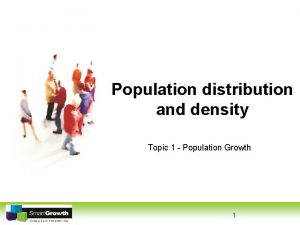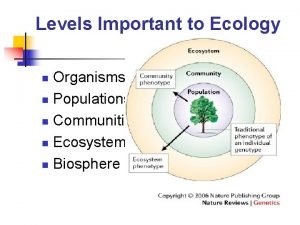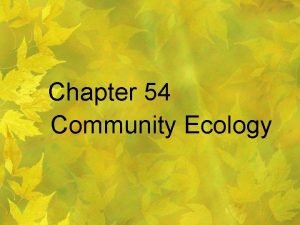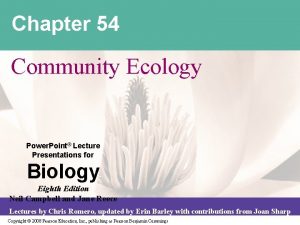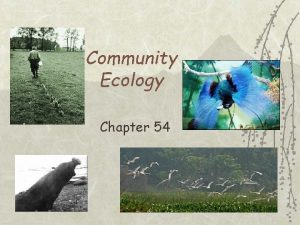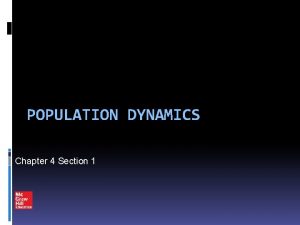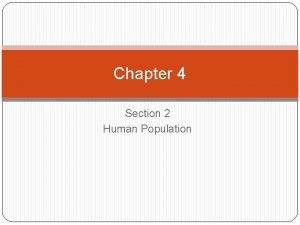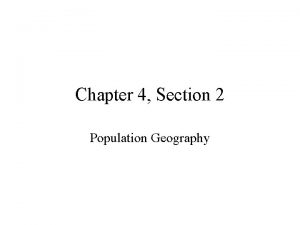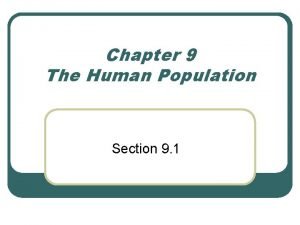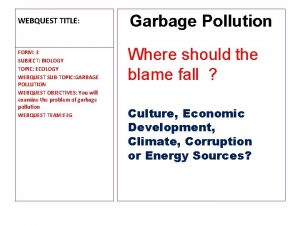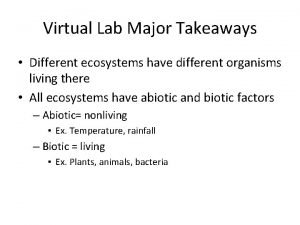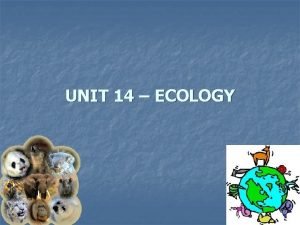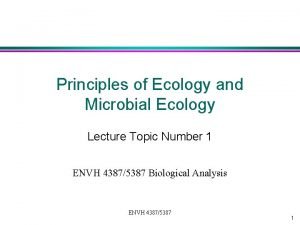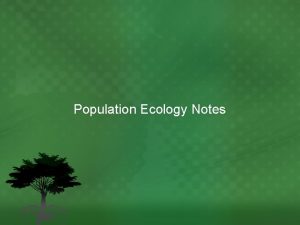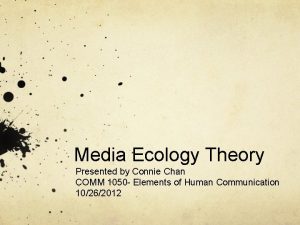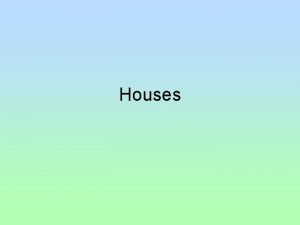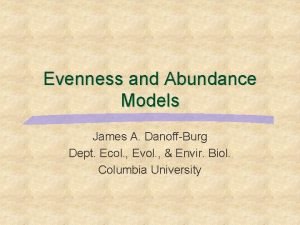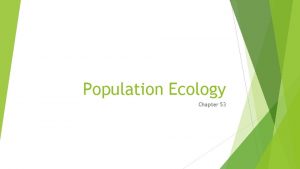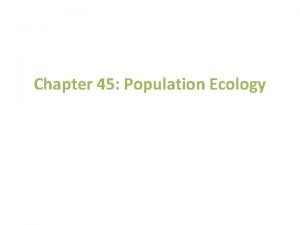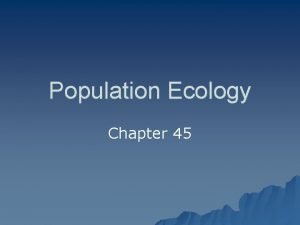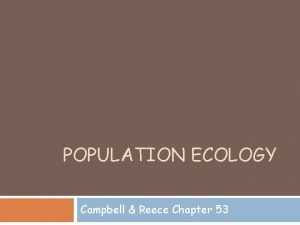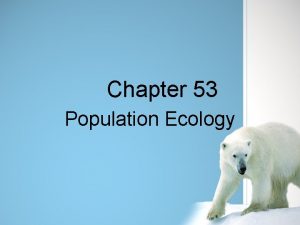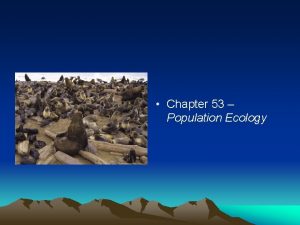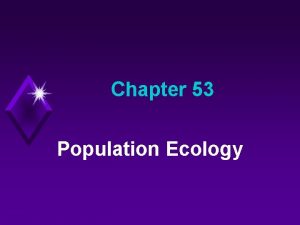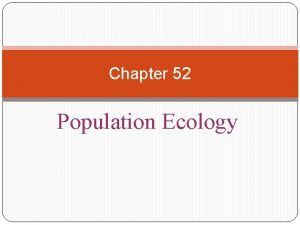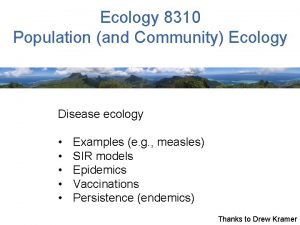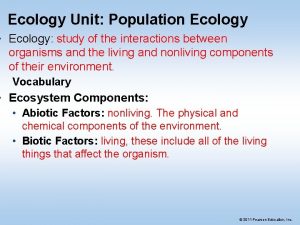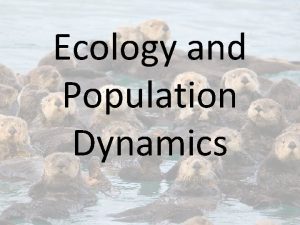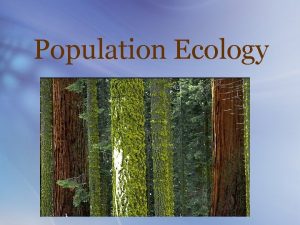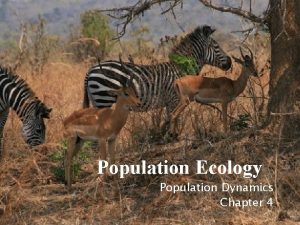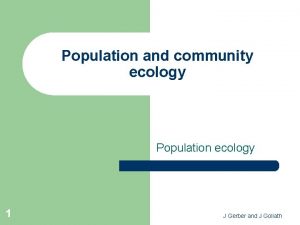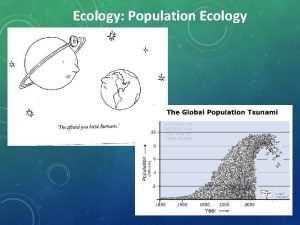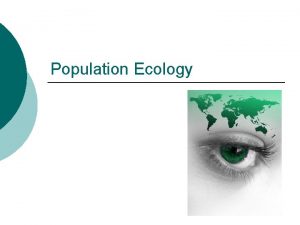Population Ecology Chapter 52 Population Ecology Population ecology



























































- Slides: 59

Population Ecology Chapter 52 Population Ecology

Population ecology is the study of populations in relation to the environment Includes environmental influences on population density and distribution, age structure, and variations in population size

Definition of a Population A population is a group of individuals of the same species living in the same general area

Density and Dispersion Density Is the number of individuals per unit area or volume Dispersion Is the pattern of spacing among individuals within the boundaries of the population

Population density results from interplay of processes that add individuals and those that remove them from the population. Immigration and birth add individuals whereas death and emigration remove individuals.

Patterns of Dispersion Environmental and social factors Influence the spacing of individuals in a population

Patterns of dispersion: clumped Clumped dispersion Individuals aggregate in patches Grouping may be result of the fact that multiple individuals can cooperate effectively (e. g. wolf pack to attack prey or antelope to avoid predators) or because of resource dispersion (e. g. mushrooms clumped on a rotting log)

Clumped organisms

Pattern of dispersion: uniform Uniform dispersion Individuals are evenly distributed Usually influenced by social interactions such as territoriality

Uniformly distributed Penguins

Pattern of dispersion: random Random dispersion: position of each individual is independent of other individuals (e. g. plants established by windblown seeds). Uncommon pattern.

Randomly distributed ferns

Demography is the study of the vital statistics of a population and how they change over time Death rates and birth rates Are of particular interest to demographers

Life Tables Life table is an age-specific summary of the survival pattern of a population (first developed by the insurance industry) Constructed by following the fate of a cohort (age-class of organisms) from birth to death.

Life table built by determining number of individuals that die in each age group and calculating the proportion of the cohort surviving from one age to the next. Data for life tables hard to collect for wild populations.


Life table for ground squirrels shows death rate for males is higher than that for females. Also, notice that mortality rate is quite consistent from one year to the next.

Survivorship Curves Data in a life table can be represented graphically by a survival curve. Curve usually based on a standardized population of 1000 individuals and the Xaxis scale is logarithmic.


Survivorship curves can be classified into three general types Number of survivors (log scale) Type I, Type II, and Type III Figure 52. 5 1, 000 I 100 II 10 III 1 0 50 Percentage of maximum life span 100

Type I curve typical of animals that produce few young but care for them well (e. g. humans, elephants). Death rate low until late in life where rate increases sharply as a result of old age (wear and tear, accumulation of cellular damage, cancer).

Type II curve has fairly steady death rate throughout life (e. g. rodents). Death is usually a result of chance processes over which the organism has little control (e. g. predation)

Type III curve typical of species that produce large numbers of young which receive little or no care (e. g. Oyster). Survival of young is dependent on luck. Larvae released into sea have only a small chance of settling on a suitable substrate. Once settled however, prospects of survival are much better and a long life is possible.

Reproductive Rates A reproductive table, or fertility schedule is an age-specific summary of the reproductive rates in a population. Measured over life span of a cohort. The fertility schedule ignores males.

Reproductive Table The table tallies the number of females produced by each age group. Product of proportion of females of a given age that are breeding and the number of female offspring of those breeding females.

Table 52. 2

Life History Study of life histories focuses on explaining why organisms differ in their reproductive patterns.

Life History Traits Life history traits are products of natural selection. Life history traits are evolutionary outcomes reflected in the development, physiology, and behavior of an organism. The current life history reflects the fact that organisms in the past that adopted this strategy left behind on average more surviving offspring than individuals who adopted other strategies.

Life history diversity Some species exhibit semelparity, or “bigbang” reproduction. These species reproduce once and die (bamboo, salmon, century plant). Century Plant

Semelparous reproduction often an adaptation to erratic climatic conditions. Suitable breeding conditions occur rarely and organisms devote all their resources to reproduction when conditions are good (e. g. century plant).

Iteroparous reproduction Some species exhibit iteroparity, or repeated reproduction and produce offspring repeatedly over time. E. g. humans, cats, birds.

Iteroparous reproduction occurs when organisms have good prospects of reproducing in the future (i. e. , they are longlived). Characteristic of larger organisms and those that experience more stable environmental conditions.

“Trade-offs” and Life Histories Organisms have finite resources, which lead to tradeoffs between survival and reproduction For example kestrels whose broods were artificially enlarged had reduced overwinter survivorship. Conversely, birds whose broods were reduced had higher overwinter survivorship.

Quantity vs. Quality of offspring Organisms face tradeoffs between the number and quality of young they can produce because they have only a limited quantity of resources to invest. The choice is basically between a few large or many small offspring.


Population growth Occurs when birth rate exceeds death rate (duh!) Organisms have enormous potential to increase their populations if not constrained by mortality. Any organism could swamp the planet in a short time if it reproduced without restraint.

Per Capita Rate of Increase If immigration and emigration are ignored, a population’s growth rate (per capita increase) equals the per capita birth rate minus the per capita death rate

Equation for population growth is ΔN/Δt = b. N-d. N Where N = population size, b is per capita birth rate and d is per capita death rate. ΔN/Δt is change in population N over a small time period t.

The per capita rate of population increase is symbolized by r. r = b-d. r indicates whether a population is growing (r >0) or declining (r<0).

Ecologists express instantaneous population growth using calculus. Zero population growth occurs when the birth rate equals the death rate r = 0. The population growth equation can be expressed as d. N r. N dt

Exponential population growth (EPG) Describes population growth in an idealized, unlimited environment. During EPG the rate of reproduction is at its maximum.

The equation for exponential population growth is d. N dt rmax. N

The J-shaped curve of exponential growth Is characteristic of some populations that are rebounding 8, 000 Elephant population 6, 000 4, 000 2, 000 0 1900 Figure 52. 10 1920 1940 Year 1960 1980

Logistic Population Growth Exponential growth cannot be sustained for long in any population. A more realistic population model limits growth by incorporating carrying capacity. Carrying capacity (K) is the maximum population size the environment can support

The Logistic Growth Model In the logistic population growth model the per capita rate of increase declines as carrying capacity is approached. We construct the logistic model by starting with the exponential model and adding an expression that reduces the per capita rate of increase as N increases

The logistic growth equation includes K, the carrying capacity (number of organisms environment can support) (K N ) d. N rmax N dt K As population size (N) increases, the equation ((K-N)/K) becomes smaller which slows the population’s growth rate.


Logistic model produces a sigmoid (S-shaped) population growth curve.

Logistic model predicts different per capita growth rates for populations at low and high density. At low density population growth rate driven primarily by r the rate at which offspring can be produced. At low density population grows rapidly. At high population density population growth is much slower as density effects exert their effect.

The Logistic Model and Real Populations The growth of laboratory populations of paramecia fits an S-shaped curve Number of Paramecium/ml 1, 000 Figure 52. 13 a 800 600 400 200 0 0 5 10 Time (days) 15 (a) A Paramecium population in the lab. The growth of Paramecium aurelia in small cultures (black dots) closely approximates logistic growth (red curve) if the experimenter maintains a constant environment.

Some populations overshoot K before settling down to a relatively stable density 180 Number of Daphnia/50 ml 150 120 90 60 30 0 0 20 40 60 80 100 120 140 160 Time (days) (b) A Daphnia population in the lab. The growth of a population of Daphnia in a small laboratory culture (black dots) does not correspond well to the logistic model (red curve). This population overshoots the carrying capacity of its artificial environment and then settles down to an approximately stable population size. Figure 52. 13 b

Some populations fluctuate greatly around K. 80 Number of females 60 40 20 0 � 1975 � 1980 � 1985 � 1990 � 1995 � 2000 Time (years) (c) A song sparrow population in its natural habitat. The population of female song sparrows nesting on Mandarte Island, British Columbia, is periodically reduced by severe winter weather, and population growth is not well described by the logistic model. Figure 52. 13 c

The Logistic Model and Life Histories Life history traits favored by natural selection may vary with population density and environmental conditions. At low density, per capita food supply is relatively high. Selection for reproducing quickly (e. g by producing many small young) should be favored. At high density selection will favor adaptations that allow organisms to survive and reproduce with few resources. Expect lower birth rates.

K-selection, or density-dependent selection Selects for life history traits that are sensitive to population density r-selection, or density-independent selection Selects for life history traits that maximize reproduction

The concepts of K-selection and r-selection have been criticized by ecologists as oversimplifications. Most organisms exhibit intermediate traits or can adjust their behavior to different conditions.

Population regulation Populations are regulated by a complex interaction of biotic and abiotic influences

Population Change and Population Density In density-independent populations birth rate and death rate do not change with population density. For example, in dune fescue grass environmental conditions kill a similar proportion of individuals regardless of density.

In contrast in density-dependent populations birth rates fall and death rates rise with population density. Density-dependent population regulation much more common than densityindependent

In density-dependent population either birth rate or death rate or both may be density dependent.
 Chapter 4 population ecology section 1 population dynamics
Chapter 4 population ecology section 1 population dynamics Chapter 4 population ecology answer key
Chapter 4 population ecology answer key Population ecology section 1 population dynamics answer key
Population ecology section 1 population dynamics answer key Population ecology section 1 population dynamics
Population ecology section 1 population dynamics Chapter 53 population ecology
Chapter 53 population ecology Equilibrial life history
Equilibrial life history Chapter 4 population ecology answer key
Chapter 4 population ecology answer key Chapter 53 population ecology
Chapter 53 population ecology Chapter 4 population ecology answer key
Chapter 4 population ecology answer key Chapter 53 population ecology
Chapter 53 population ecology Population ecology example
Population ecology example Logistic growth ecology definition
Logistic growth ecology definition Fig 52
Fig 52 Population vs community ecology
Population vs community ecology Concept 3 population ecology
Concept 3 population ecology Population def ecology
Population def ecology Characteristics of population ecology
Characteristics of population ecology Population characteristics
Population characteristics Ideal population growth curve
Ideal population growth curve Population definition ecology
Population definition ecology Population distribution
Population distribution Parasitism
Parasitism Chapter 52: an introduction to ecology and the biosphere
Chapter 52: an introduction to ecology and the biosphere Chapter 3 section 1: community ecology
Chapter 3 section 1: community ecology Chapter 56 conservation biology and restoration ecology
Chapter 56 conservation biology and restoration ecology Chapter 55 ecosystems and restoration ecology
Chapter 55 ecosystems and restoration ecology Chapter 54: community ecology answer key
Chapter 54: community ecology answer key Chaparral climograph
Chaparral climograph Evolution and community ecology guided notes
Evolution and community ecology guided notes Chapter 2 principles of ecology
Chapter 2 principles of ecology Principles of ecology chapter 2 section 3 answer key
Principles of ecology chapter 2 section 3 answer key Chapter 2 section 1 organisms and their relationships
Chapter 2 section 1 organisms and their relationships More diverse
More diverse Chapter 55 ecosystems and restoration ecology
Chapter 55 ecosystems and restoration ecology Chapter 5 evolution and community ecology
Chapter 5 evolution and community ecology Chapter 5 evolution and community ecology answer key
Chapter 5 evolution and community ecology answer key Principles of ecology section 2 flow of energy
Principles of ecology section 2 flow of energy Chapter 54 community ecology
Chapter 54 community ecology Whats a density independent factor
Whats a density independent factor Chapter 4 section 2 human population
Chapter 4 section 2 human population Chapter 4 section 2 population geography
Chapter 4 section 2 population geography Key issue 3 why do some places face health challenges
Key issue 3 why do some places face health challenges Chapter 9 the human population section 1
Chapter 9 the human population section 1 Ecology webquest answers
Ecology webquest answers Food chain virtual lab
Food chain virtual lab Unit 7 ecology answer key
Unit 7 ecology answer key Parasitism
Parasitism Perceptual region definition
Perceptual region definition Cultural ecology ap human geography
Cultural ecology ap human geography Undesired change in air water soil
Undesired change in air water soil Whats climax community
Whats climax community Ecology deals with
Ecology deals with Niche definition biology
Niche definition biology Biotic potential
Biotic potential Gendina
Gendina What is media ecology
What is media ecology Organismal ecology
Organismal ecology Folk housing
Folk housing What biome has bison
What biome has bison Broken stick model
Broken stick model




















